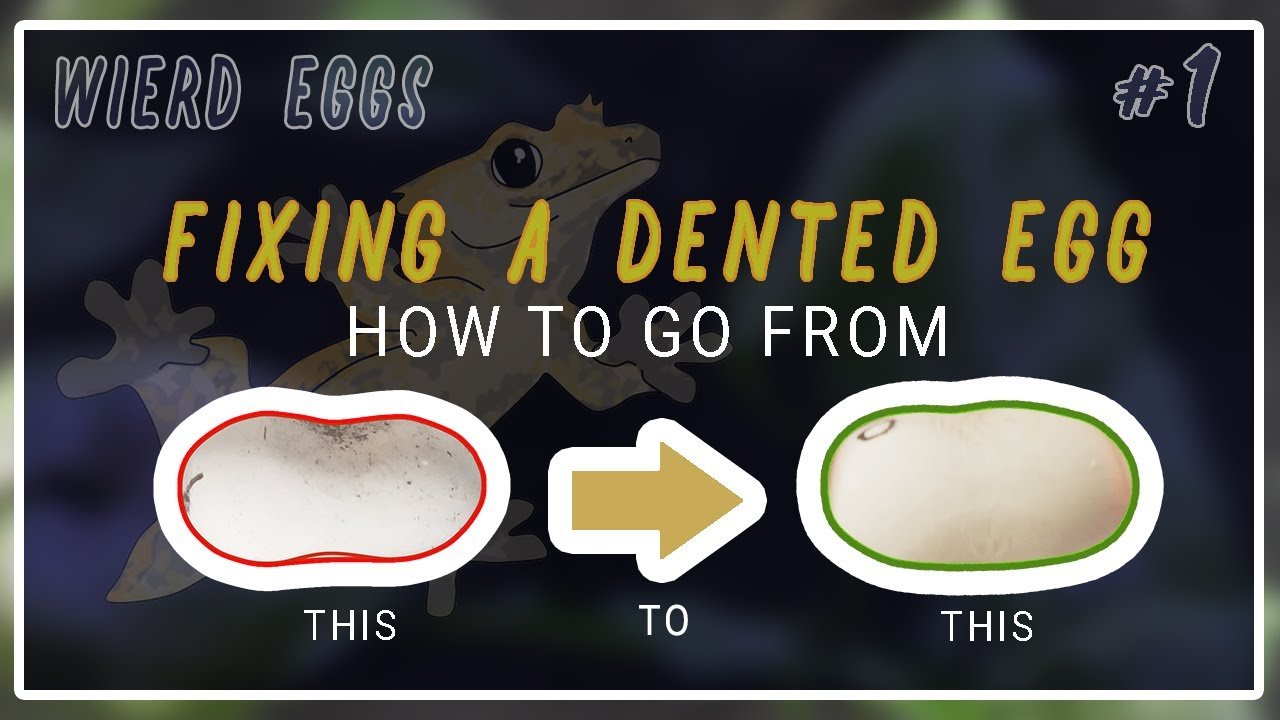Why are My Leopard Gecko Eggs Dented

There are many reasons why leopard gecko eggs may become dented. One reason is that the female may have been too rough when laying the eggs, causing them to become dented in the process. Another reason is that the eggs may have been placed in an incubator that was not humid enough, causing the eggshells to dry out and become brittle.
Finally, if the temperature in the incubator fluctuates too much, it can also cause the eggshells to become weak and collapse.
If you’ve ever incubated leopard gecko eggs, you may have noticed that some of them develop small dents or divots on their shells. While this may seem like a cause for concern, it’s actually quite normal!There are a few reasons why leopard gecko eggs might develop dents.
One possibility is that the egg was accidentally dropped or bumped during incubation. Another possibility is that the egg was too dry when it was first laid and the shell didn’t form properly.either way, Eggs with small dents are usually still perfectly fine and will hatch without any problems.
So don’t worry if you see a few dents on your leopard gecko eggs – they’re probably nothing to worry about!

Credit: www.reddit.com
How Can You Tell If a Leopard Gecko Egg is Bad?
If you’re wondering how to tell if a leopard gecko egg is bad, there are a few things you can look for. First, check the egg for any cracks or discoloration. If the egg is cracked or has any strange markings on it, it’s probably not viable.
Second, take a close look at the size and shape of the egg. If it’s misshapen or significantly smaller than other eggs in the clutch, it’s likely not going to hatch. Finally, give the egg a gentle shake.
If you hear fluid sloshing around inside, that means the embryo has died and the egg is no longer good.
Will a Dented Egg Hatch?
Eggs are pretty resilient, and a little dent here and there usually won’t affect whether or not it will hatch. However, if the egg is cracked, then it is likely that the embryo inside will not survive. So, if you have a dented egg, don’t worry too much – it should still be fine.
But if it’s cracked, you might want to consider getting rid of it.
Why are My Crested Gecko Eggs Denting?
If you find that your crested gecko eggs are denting, it is most likely due to the fact that they are not being incubated properly. Incubation is a very important process for reptile eggs, as it helps to keep them warm and humid so that they can develop properly. If the conditions are not ideal, the eggs can start to shrink and collapse, which will cause them to lose moisture and eventually die.
The best way to ensure that your crested gecko eggs are incubating properly is to use an egg incubator. These devices are designed to maintain the correct temperature and humidity levels for reptiles eggs, and will help to prevent any problems from occurring. There are a variety of different types of egg incubators available on the market, so be sure to do some research before purchasing one.
What Do Infertile Leopard Gecko Eggs Look Like?
If you’re wondering what leopard gecko eggs that are infertile look like, you’re not alone. Many leopard gecko owners find themselves in the same situation at some point. After all, Leopard geckos are oviparous, meaning they lay eggs rather than giving birth to live young.
So, what do these infertile eggs look like? Well, they typically have a white or clear appearance and are smaller in size than fertile eggs. They may also have an irregular shape or be misshapen.
If you think your leopard gecko has laid an infertile egg, don’t despair. There are a number of things you can do to help increase the chances of fertility next time around. For example, make sure your pet is well-fed and has access to plenty of water.
You might also want to consider using a different substrate for nesting purposes (such as sphagnum moss) as this can improve drainage and aeration around the eggs.With proper care and attention, there’s no reason why your leopard gecko can’t produce a healthy clutch of fertilized eggs in the future!
Fixing a dented egg- Crested Gecko How To
How Long Does It Take for Leopard Gecko Eggs to Hatch
Leopard gecko eggs hatch anywhere from 45 to 60 days after they are laid. The incubation temperature can impact the hatching time, with cooler temperatures resulting in a longer incubation period. After the eggs hatch, the baby leopard geckos will be about 3-4 inches long.
Leopard Gecko Eggs Fertile Or Infertile
If you’re wondering whether your leopard gecko eggs are fertile or not, there are a few things you can look for to help you determine the answer. One is the appearance of the eggs – fertile eggs will usually be slightly opaque, while infertile ones will be more clear. Another is whether or not the eggs are attached to each other – if they’re not, it’s likely that they’re infertile.
Finally, you can try candling the eggs (holding them up to a bright light) to see if there are any developing embryos inside – if so, they’re probably fertile!If you’re still unsure, your best bet is to consult with a reptile vet or experienced breeder who can help you confirm whether or not your leopard gecko eggs are fertile.
How to Incubate Leopard Gecko Eggs
Leopard gecko eggs are relatively easy to incubate, as long as you follow a few simple steps. Here’s what you need to know:1. Collect the eggs.
If your leopard gecko is gravid (i.e., pregnant), she will lay her eggs in a secluded, safe place. Once she lays them, you can collect them and transfer them to the incubation container.2. Choose an incubation medium.
There are several different types of materials that can be used for incubating leopard gecko eggs, including vermiculite, sphagnum moss, and perlite. Each of these has its own pros and cons, so it’s important to do some research to decide which one is right for you.3. Maintain proper humidity levels.
Leopard gecko eggs need to be kept at a relative humidity of 50-60%. This can be accomplished by misting the incubation medium on a regular basis or using a humidifier in the room where the eggs are being stored.4 .
Keep the eggs at a consistent temperature . Leopard gecko eggs should be kept at a constant temperature between 82-86 degrees Fahrenheit . This can be achieved with the use of an reptile heat mat or other similar heating device .
5 Monitor the progress of the embryos . As the embryos develop , they will begin to “pip” , meaning they will make small holes in their egg shells as they prepare to hatch . At this point , it is important not to disturb them too much , as they are very fragile .
6 Assist with hatching if necessary . In some cases , newly hatched leopard geckos may have difficulty emerging from their eggshells on their own . If this happens , you can carefully help them out by gently breaking away any pieces of shell that are blocking their exit . 7 Enjoy your new baby leopard geckos ! Once they have successfully hatched , your baby leopard geckos will need food , water , and shelter just like any other animal would . Be sure to do your research so that you can provide them with everything they need to thrive !
Are Dented Leopard Gecko Eggs Always Infertile?
Are Dented Leopard Gecko Eggs Always Infertile?
Dented leopard gecko eggs are not always infertile. While infertility can be one of the leopard gecko egg infertility reasons, dented eggs can also indicate other factors like humidity fluctuations or incorrect incubation conditions. It is crucial to monitor the eggs closely and seek advice from reptile specialists to ensure the best chances of successful hatching.
Does a Pale Leopard Gecko Indicate a Problem with the Eggs?
A pale coloration in leopard geckos may be indicative of underlying health issues affecting the eggs. It could possibly be a symptom of calcium deficiency, leading to weak shells or improper embryonic development. Monitoring the leopard gecko’s pale coloration symptoms can be crucial in identifying and addressing potential problems with the eggs to ensure the health and vitality of future offspring.
How to Tell If Leopard Gecko Eggs are Fertile
When it comes to leopard gecko eggs, there are a few things you need to look for in order to determine if they are fertile. The first is the appearance of the egg. A healthy, fertile egg will be smooth and round with a hard shell.
If an egg is misshapen or has a soft shell, it is likely not fertile.The next thing you’ll want to look at is the color of the egg. A healthy, fertilized egg will be white or pale yellow in color.
If an egg is dark brown or black, it is probably not fertilized.Finally, you’ll want to check for blood spots on the surface of the egg. Blood spots indicate that the embryo inside has died and thus the egg is not viable.
With all of these factors in mind, you should be able to tell if your leopard gecko’s eggs are fertile!
Conclusion
If you’ve ever found a leopard gecko egg that’s dented, you’re probably wondering why. There are a few reasons why this could happen. The first is that the egg was dropped.
This can happen if the female leopard gecko is not careful when she’s laying her eggs. Another reason why an egg might be dented is because of something called “pipping.” Pipping is when the baby leopard gecko starts to hatch from its egg and makes a small hole in the shell.
This can cause the egg to collapse and look dented. If you find a dented egg, don’t worry too much. The chances are good that the baby leopard gecko will be just fine.